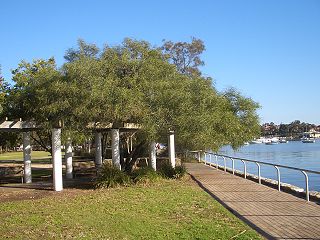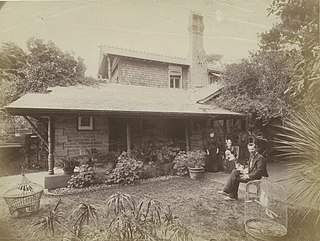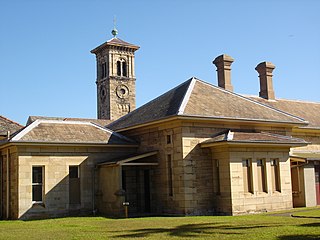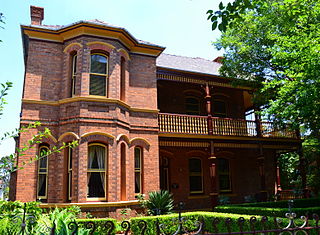
Glebe is an inner-western suburb of Sydney in New South Wales. Glebe is located 3 kilometres (1.9 mi) southwest of the Sydney central business district and is part of the local government area of the City of Sydney, in the Inner West region.

Lilyfield is a suburb in the Inner West of Sydney, in the state of New South Wales, Australia. Lilyfield is located 6 kilometres west of the Sydney central business district, in the local government area of the Inner West Council.

Rozelle is a suburb in the inner west of Sydney, in the state of New South Wales, Australia. It is located 4 kilometres west of the Sydney central business district, in the local government area of the Inner West Council.

Paddington is an upscale Eastern Suburb of Sydney, in the state of New South Wales, Australia. Located 3 kilometres (1.9 mi) east of the Sydney central business district, Paddington lies across two local government areas. The portion south of Oxford Street lies within the City of Sydney, while the portion north of Oxford Street lies within the Municipality of Woollahra. It is often colloquially referred to as "Paddo".

The Sydney College of the Arts (SCA) is a contemporary art school that was a faculty of the University of Sydney from 1990 until 2017, when it became a school of the Faculty of Arts and Social Sciences. Until the end of 2019, the campus was located in Rozelle, Sydney and housed within Callan Park in the Kirkbride complex, a cluster of sandstone buildings designed by James Barnet, the government architect, in the late 19th century. SCA moved to the main Camperdown Campus of the University of Sydney in 2020 and now occupies a substantial portion of the Old Teachers' College.

The Municipality of Leichhardt was a local government area in the inner-west region of Sydney, New South Wales, Australia. It is about 10 kilometres (6.2 mi) west of the Sydney central business district. On 12 May 2016, Leichhardt merged with Marrickville Council and the Municipality of Ashfield to form the Inner West Council.

Iron Cove is a bay on the Parramatta River, in the inner-west of Sydney, in the state of New South Wales, Australia. It is approximately 5 kilometres (3.1 mi) due west of Sydney's central business district. It is surrounded by the suburbs of Birchgrove, Balmain, Rozelle, Lilyfield, Haberfield, Five Dock, Rodd Point, Russell Lea and Drummoyne. The bay extends from Longnose Point to the south-west and is fed by the Hawthorne Canal and the Iron Cove Creek.

John Horbury Hunt, often referred to as Horbury Hunt, was a Canadian-born Australian architect who worked in Sydney and rural New South Wales from 1863.

Callan Park, with the heritage listed name Callan Park Conservation Area & Buildings, is a 60-hectare (150-acre) heritage listed site in Lilyfield, a suburb in the Inner West Council in the Inner West of Sydney, in the state of New South Wales, Australia.

The Callan Park Hospital for the Insane (1878–1914) is a heritage-listed former insane asylum, which was subsequently, for a time, used as a college campus, located in the grounds of Callan Park, an area on the shores of Iron Cove in Lilyfield, a suburb of Sydney, New South Wales, Australia. In 1915, the facility was renamed as the Callan Park Mental Hospital and, again in 1976, to Callan Park Hospital. Since 1994, the facility has been formally known as Rozelle Hospital. In April 2008, all Rozelle Hospital services and patients were transferred to Concord Hospital. The Callan Park Act, 2002 (NSW) restricts future uses of the site to health, tertiary education and community uses.

Annandale is a suburb in the Inner West of Sydney, in the state of New South Wales, Australia. Annandale is located within 5 kilometres west of the Sydney central business district and is part of the local government area of the Inner West Council. Annandale's northern end lies on Rozelle Bay, which is on Sydney Harbour. Glebe lies to its east, Lilyfield and Leichhardt to its west and Stanmore and Camperdown to its south.

Whites Creek, formerly known as White's Creek, was once a natural waterway that was concreted to improve sanitation. The creek is now a heritage–listed artificial waterway located in the inner–west region of Sydney, New South Wales, Australia.

Rivendell Child, Adolescent and Family Unit is a mental health facility specialising in the problems of young people. It is located at Hospital Road, Concord West, New South Wales, Australia. The facility is housed in the former Thomas Walker Hospital, which is listed on the New South Wales Heritage Register.

The Gladesville Mental Hospital, formerly known as the Tarban Creek Lunatic Asylum, was a psychiatric hospital established in 1838 in the Sydney suburb of Gladesville. The hospital officially closed in 1993, with the last inpatient services ceasing in 1997.

Mortimer William Lewis was an English-born architect, surveyor and public servant who migrated to Australia and became Colonial Architect in the colony of New South Wales from 1835 to 1849. Lewis was responsible for designing and overseeing many government buildings in Sydney and rural New South Wales, many of which are heritage listed.

Woodstock is a heritage-listed mansion in the Sydney suburb of Burwood, New South Wales, Australia. It was built between c. 1866 and 1873 by Edwin Thomas Penfold and changed hands a number of times before being acquired by Burwood Council. During World War II the property was acquired by the Australian Government for military purposes. The Victorian Italianate villa is listed on the Australian Register of the National Estate and the Burwood Council local government heritage list.

Monteith is a heritage-listed residence at located 266 Glebe Point Road in the inner western Sydney suburb of Glebe in the City of Sydney local government area of New South Wales, Australia. It was built in 1890. It was added to the New South Wales State Heritage Register on 2 April 1999.

Lyndhurst is a heritage-listed residence and former school, laundry, maternity hospital and industrial building located at 61 Darghan Street in the inner western Sydney suburb of Glebe in the City of Sydney local government area of New South Wales, Australia. It was designed by John Verge and built from 1833 to 1837. The property is owned by Historic Houses Trust of New South Wales. It was added to the New South Wales State Heritage Register on 2 April 1999.




















